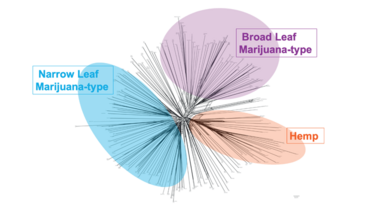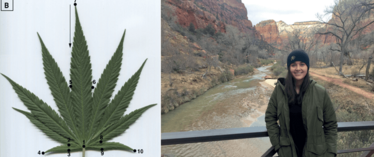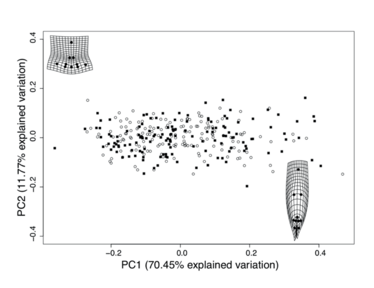
What’s in a Shape?
… that which we call BLMT in any other shape would smell as pungent
Back in the summer of 2015, I was busy helping collect physical trait information from the results of a hemp-BLMT cross – 300 plants in all! In 2021 – on April 20 (4/20!) – we published our results (1), and I hope you’ll agree that all the hard work was well worth it. Before we get to our findings (the paper title is more than a teaser!), a little background reading...
Even though Cannabis is considered as one species (Cannabis sativa L), according to Carl Linnaeus (who classified it in 1753), we know there are at least three groupings within C. sativa (1; see Figure 1). These three groupings include industrial hemp, and two other clusters that are used in medicinal and recreational settings – broad-leaf marijuana type (BLMT) and narrow-leaf marijuana type (NLMT) – as shown in Figure 1.

Figure 1. Three groups (BLMT in purple, NLMT in blue, and Hemp in orange) after the analysis of the whole collection of DNA (genome) from approximately 200 varieties. Each tip in this Splits Tree graph is a Cannabis variety. The closer the strains, the more related they are and therefore the more of the genome they share.
Currently the cannabisindustry’s colloquial – and misleading – information wrongfully groups Cannabis plants based on the leaf shape or cannabinoid content, particularly THC and CBD. For example, from a legal perspective, the state of Colorado classifies any Cannabis plant that produces less than 0.3 percent THC as hemp; however, biologically, such plants could cluster within the BLMTs or NLMTs rather than with hemp. Indeed, this is the case of the variety Otto, which is not a hemp cultivar but a hybrid between the NLMTs and hemp (see Figure 2). These problems in nomenclature have been previously been discussed by Jason Sawler and collaborators (1); they showed that, even though the industry assures us that two cultivars are 100 percent “sativa” they might be distantly related; equally, two varieties that are colloquially classified as “sativa” and “indica” may be closely related. My colleagues and I also discussed these issues within the industry (2).
To understand whether diverse traits, such as leaf shape and cannabinoid production, are correlated to each other and to define groups, such as the misidentified “indica” or “sativa,” we decided to analyze a cross between a hemp type individual (Carmagnola) and a BLMT (Afghan Kush). The seeds, the cross, and the maintenance of the plants was performed by Ben Holmes from Centennial Seeds (www.centennialseeds.com), who kindly donated his time and resources to the project. Thank you again, Ben!

Figure 2. Both panels offer close-ups of Figure 1. In the first panel, the variety “Otto” is highlighted in purple; note how it falls as a hybrid between the NLMT (blue) and the Hemp groupings. The second panel shows varieties from the NLMT grouping; accurately-labeled strains are closely related to a cultivar with the same name (highlighted in yellow). Other strains are mislabeled and are more closely related to varieties with different names (highlighted in red). The BLMT group presents the same issue (not shown).
And so, during the summer of 2015, we collected physical trait information from each of the 300 offspring of this cross, including cannabinoid content and leaf scans (see Figure 3). Cellene Feathers, now a Masters’ student in Education, analyzed the phenotypic data from the offspring of the hemp-kush cross. The same offspring were also sequenced for further genomic analysis and to develop a genetic map, with funding provided by the Institute for Cannabis Research (ICR) from CSU Pueblo. The genetic map provides the location of particular genes, associating the specific positions of the physical traits from Cellene’s analysis to the genome.

Figure 3. Pictures from summer 2015 where 300 offspring from a cross between a hemp and an Afghan Kush were measured. Nolan Kane (left), Jacob Haas and Ezra Huscher (members of the Kane lab in the center), and Daniela Vergara (right).
Given the existence of BLMT and NLMT, we were particularly interested in leaf shape. For every leaf scan of the 300 offspring, Cellene placed ten points (landmarks) in the same location (see Figure 4) for further analysis with a robust technique called geometric morphometrics (GM). GM allowed us to compare the 300 leaf shapes statistically before correlation with other physical characteristics, such as cannabinoid content.

Figure 4. Ten landmarks placed in each of the leaf pictures of 300 offspring from the hemp-kush cross for leaf shape analysis. (Left). Cellene Feathers, student who measured the 300 individuals (right).
Firstly, our results showed that leaf shape varies in the offspring (3). The morphospace – that is, the graphical representation of the possible form, shape, or structure of an organism – highlights that, at one extreme, the leaves tend to be squat with the outer leaflets pointing to the sides (see Figure 5, top left), while, at the other extreme, the leaves tend to be elongated with the outer leaflets pointing downwards (see Figure 5, bottom right). Notably, leaf shape is not related to plant sex. In other words, males can have an elongated or squat leaf – just like the females.

Figure 5. Morphospace of leaf shape for 300 individuals. Filled squares denote males, empty circles denote females. Top right inset figure shows the leaf tendencies in that extreme of the morphospace, with leaves being squat and the outer leaflets pointing outwards. Bottom left inset figure shows the tendencies in leaf shape for that extreme of the morphospace with leaves being elongated and the outer leaflets pointing downwards. This morphospace figure shows 82% of the total variation in leaf shape.

Figure 6. Leaf shape (X axis) does not explain cannabinoid production (Y axis). In other words, leaf shape and cannabinoid levels are two phenotypic traits that are independent of each other. Also sex is independent of both cannabinoid production or leaf shape (Filled squares denote males, empty circles denote females).
Secondly, leaf shape variation is not correlated to either THC or CBD production (see Figure 6); in other words, irrespective of narrow or broad leaf shape, a given plant can produce high or low THC or high or low CBD.
What’s the main take home message? Our results suggest that the traits considered to be important by the cannabisindustry – namely, leaf shape and cannabinoid content – are:
i) governed by different genomic regions,
ii) independent of each other,
iii) subject to independent assortment (shuffling).
A simple analogy: if a person told you in a dating site chat room that they had blue eyes, would you jump to a conclusion about their height, hair color, and sex? Nope!
- Vergara et al., “Widely assumed phenotypic associations in Cannabis sativa lack a shared genetic basis,” PeerJ, 20, 9:e10672 (2021). PMID: 33976953.
- J Sawler et al., “The genetic structure of marijuana and hemp,” PLoS one, 10, e0133292 (2015). PMID: 26308334
- D Vergara et al., “Genetic and genomic tools for Cannabis sativa,” CRC Crit Rev Plant Sci, 35, 364 (2016).












